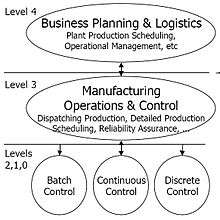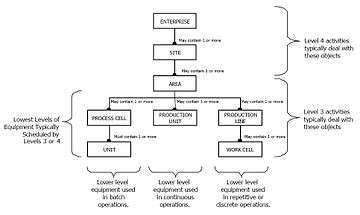Purdue Enterprise Reference Architecture
Purdue Enterprise Reference Architecture (PERA) is a 1990s reference model for enterprise architecture, developed by Theodore J. Williams and members of the Industry-Purdue University Consortium for Computer Integrated Manufacturing.[1]

Overview
PERA is a reference architecture that can model the enterprise in multiple layers and in multiple stages of the architectural life cycle. Initially PERA was part of the PERA methodology, which consisted of three main building blocks:[2]
- Purdue Enterprise Reference Architecture,
- Purdue Reference Model, and
- Purdue implementation procedures manual

PERA has been further developed, and according to Gary Rathwell PERA, nowadays consists of the following components:[3]
- The PERA Enterprise Life-cycle Framework or Model or Architecture...
- Concepts of maximum and minimum lines of automation...
- Concepts explaining the effect of recycle and time delays on the design and operation of facilities.
- The PERA Master Planning Methodology
- Concepts for dividing Enterprise Systems into Physical and Logical Architectures.
- Purdue Reference Model for CIM including Generic Reference Data Flow Models.
- Example Logical System Architectures from various industries...
- Physical Systems Architecture Concepts including "Levels" and the "4Rs".
- Example Physical architectures from various industries ...
- Mapping of hardware and software products within the PERA Framework
Later in the 1990s combined insights from PERA, and other reference architectures such as GRAI Integrated Methodology, CIM-OSA, and TOVIE has led to the development of the Generic Enterprise Reference Architecture and Methodology [4]
Levels for enterprise integration
Purdue Reference Model, “95” provides a model for enterprise control, which end users, integrators and vendors can share in integrating applications at key[5] layers in the enterprise:
- Level 0 — The physical process — Defines the actual physical processes.
- Level 1 — Intelligent devices — Sensing and manipulating the physical processes. Process *sensors, analyzers, actuators and related instrumentation.
- Level 2 — Control systems — Supervising, monitoring and controlling the physical processes. Real-time controls and software; DCS, human-machine interface (HMI); supervisory and data acquisition (SCADA) software.
- Level 3 — Manufacturing operations systems — Managing production work flow to produce the desired products. Batch management; manufacturing execution/operations management systems (MES/MOMS); laboratory, maintenance and plant performance management systems; data historians and related middleware. Time frame: shifts, hours, minutes, seconds.
- Level 4 — Business logistics systems — Managing the business-related activities of the manufacturing operation. ERP is the primary system; establishes the basic plant production schedule, material use, shipping and inventory levels. Time frame: months, weeks, days, shifts.
Publications
- Peter Bernus and Laszlo Nemes (1996) "A framework to define a generic enterprise reference architecture and methodology." Computer Integrated Manufacturing Systems Vol 9 (3). p. 179-191.
- David Chen, Bruno Vallespir, and Guy Doumeingts (1997). "GRAI integrated methodology and its mapping onto generic enterprise reference architecture and methodology." Computers in industry Vol 33 (2). p. 387-394.
- Theodore J. Williams (1992) The Purdue enterprise reference architecture: a technical guide for CIM planning and implementation. Research Triangle Park, NC: Instrument Society of America.
- Theodore J. Williams (1993) "The Purdue enterprise reference architecture." Proceedings of the JSPE/IFIP TC5/WG5. 3 Workshop on the Design of Information Infrastructure Systems for Manufacturing. North-Holland Publishing Co.
- Theodore J. Williams (1994) "The Purdue enterprise reference architecture." Computers in industry Vol 24 (2). p. 141-158.
References
- Jaap Schekkerman (2004) How to Survive in the Jungle of Enterprise Architecture. p. 183
- Sanjay B. Joshi, Jeffrey S. Smith (1994) Computer Control of Flexible Manufacturing Systems. p. 7
- Gary Rathwell (2000-13) What is PERA? on pera.net, Accessed August 2, 2013.
- Peter Bernus and Laszlo Nemes (1996) "A framework to define a generic enterprise reference architecture and methodology." Computer Integrated Manufacturing Systems Vol 9 (3) p. 179
- Control Global Magazine
External links
| Wikimedia Commons has media related to Purdue Enterprise Reference Architecture. |
- PERA Enterprise Integration Web Site
- MES Center Association, MES Center is a non-profit organization that provides information and trends to those who are interested in control and monitoring of production processes, detailed scheduling, production logistics, production quality management and maintenance from the perspective of MES / MOM information systems
- MES Center Association, MES system as an integration tool